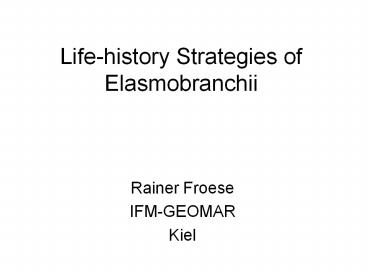Life-history Strategies of Elasmobranchii PowerPoint PPT Presentation
Title: Life-history Strategies of Elasmobranchii
1
Life-history Strategies of Elasmobranchii
- Rainer Froese
- IFM-GEOMAR
- Kiel
2
There are Six Classes of Fishes
Classes Common ancestor (million y) Orders (n) Families (n) Genera (n) Species (n, ) Species (n, )
Myxini (hagfishes) 600 1 1 6 71 0.2
Cephalaspidomorphi (lampreys) 450 1 1 9 42 0.1
Holocephali (chimaeras) 420 1 3 6 38 0.1
Elasmobranchii (sharks and rays) 420 11 45 175 975 3.4
Sarcopterygii (lobe-finned fishes) 420 3 4 4 11 0.04
Actinopterygii (ray-finned fishes) 400 45 470 4,640 28,363 96.1
Total 62 524 4,840 29,500 100
Source FishBase 09/2006
3
Most Fishes are Small
Frequency distribution of maximum lengths in
23,685 species of fishes. Median 15.9 cm.
4
Most Sharks are Large
very large
large
medium
small
Myxini with median 49 cm Cephalaspidomorphi with
median 22 cm Holocephali with median 99 cm
Elasmobranchii with median 78 cm
Sarcopterygii with median 125 cm and
Actinopterygii with median 16 cm.
5
Most Fishes are Low-level Predators
herb
low-level predator
omnivore
mid
top predator
Frequency distribution of trophic levels for
7,500 species of fishes median 3.4
6
Most Sharks are Mid-level Predators
Trophic level by Class for 7,500 species with
available data Myxini with median 4.2
Cephalaspidomorphi with median 4.2 Holocephali
with median 3.5 Elasmobranchii with median
4.0 Sarcopterygii with median 3.4 and
Actinopterygii with median 3.4.
7
How to Estimate Productivity
Parameter High Medium Low Very low
rmax (1/year) gt 0.5 0.16 0.50 0.05 0.15 lt 0.05
td (years) lt1.4 1.4 - 4.4 4.5 - 14 gt 14
Interest rate () gt 65 17 65 5 - 16 lt 5
K (1/year) gt 0.5 0.2 0.5 0.1 0.2 lt 0.1
Fecundity (1/year) gt 10,000 100 1000 10 100 lt 10
tm (years) lt 1 2 4 5 10 gt 10
tmax (years) 1 3 4 10 11 30 gt 30
Modified after Musick (1999)
8
Most Fishes have High Productivity
Observed (n 2,621) and modeled (n 24,649)
productivities of fishes. Source FishBase
11/2004 Froese 2005
9
Sharks have Low or Very Low Productivity
Class / Productivity High Medium Low Very low n rmax
Myxini 66 66 0.10
Cephalaspidomorphi 7 10 17 0.15
Holocephali 37 37 0.10
Elasmobranchii 580 212 792 0.08
Sarcopterygii 10 10 0.025
Actinopterygii 410 1059 474 67 2,010 0.30
10
Occupation of Size-Troph Space
11
Occupation of Size-Productivity Space
12
Occupation of sizeproductivitytroph-space for
20,480 species of fishes. Full cell width is
1000 species.
13
Occupation of sizeproductivitytroph-space for
620 species of sharks and rays. Full cell width
is 1000 species.
14
Occupation of sizeproductivitytroph-space for
620 species of sharks and rays. Full cell width
is 145 species.
15
Competition among Low-level Predators
Length group Product. Myx Ceph Holo Elasmo Sarco Actino
Medium Medium 4 2,752
Low 7 2 74 260
Very low 3 1 51
Large Medium 645
Low 20 18 145 429
Very low 40 7 167
Very large Very low 5 5
16
Competition betweenMid-level Predators
Length group Product. Myx Ceph Holo Elasmo Sarco Actino
Medium Medium 14 418
Low 17 2 28 33
Very low 5 5
Large Medium 368
Low 6 123 181
Very low 59 1 61
Very large Low 6 1
Very low 7 2
17
Competition among Top-Predators
Length group Productivity Myx Ceph Holo Elasmo Sarco Actino
Medium Medium 98
Low 4 7 7 9
Large Medium 188
Low 18 4 47 120
Very low 45 2 44
Very large Medium 4
Low 9 7
Very low 17 2
18
Strategies vs Species Numbers
Number of strategies used by phylogenetic Classes
plotted over number of recent species in the
Class, with linear regression line forced through
the origin slope 0.37
19
Salinity Tolerance
12,889 14,091
20
Climate Zones
3,194 4,023 16,840
21
Oceans
4,448 5,592 9,839
22
Habitat
4,137 9,953 8,732
23
Relative Brain Size
519
24
Reproductive Guild
25
Migratory Behaviour
1,872
26
Summary
- Elasmobranchs are the second largest Class of
recent fishes - They use only 16 life-history strategies compared
with 49 used by ray-finned fishes - They are mostly large, marine, demersal,
migratory, large-brained, long-living mid-level
predators of low productivity - Their low productivity makes them vulnerable to
exploitation and to competition from ray-finned
fishes with typically higher productivity
27
Thank You

